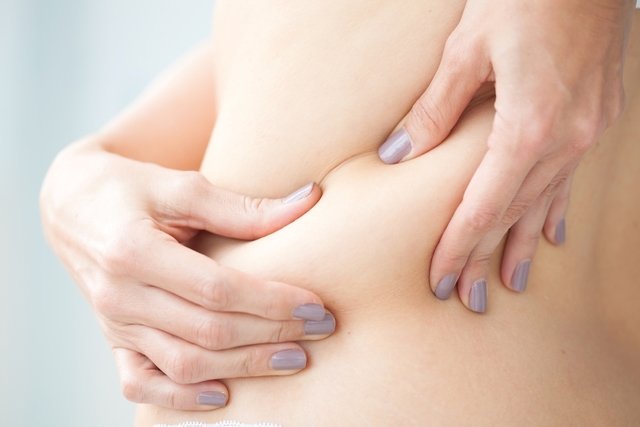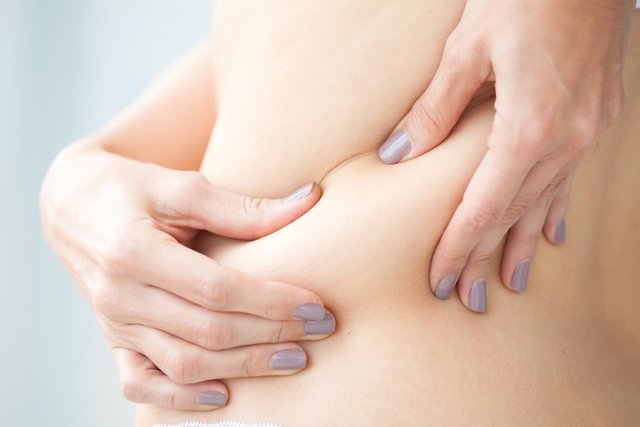Carboxytherapy is a great aesthetic treatment for eliminating localized fat, because the carbon dioxide applied to the region can promote the exit of fat from the cells responsible for storing it, the adipocytes, helping to eliminate localized fat. This type of treatment can be used to combat localized fat present on the belly, thighs, arms, flanks, buttocks and side of the back.
The results of carboxytherapy for localized fat usually appear after the 3rd treatment session, however, for the effect to be lasting, it is important that the person has a healthy, balanced diet and practices physical activity regularly.

How it works
In carboxytherapy, medicinal carbon dioxide introduced into the skin and adipose tissue causes a small injury to the cells that store fat, adipocytes, promoting the release of this fat, which becomes available to be used as a source of energy.
Carboxytherapy also leads to increased blood flow and microcirculation, which increases local oxygenation, contributing to the elimination of toxins and also increases collagen fibers, which makes the skin firmer. This reduces localized fat and improves the firmness of the skin in this region, achieving excellent results.
Despite having great results, this treatment is not recommended for weight loss as it only has an effect on a localized area, and is therefore best suited for people who are at or very close to their ideal weight, with a body mass index of up to 23.
These people may appear thin, but have a ‘tire’ of fat on their belly, sides, triceps and bra line, for example, which can cause discomfort or discomfort, for example. Therefore, carboxytherapy is a great strategy for improving body contouring by eliminating accumulated fat in some regions of the body. Find out what your BMI is by entering your details below:
Results of carboxytherapy for localized fat
The results of carboxytherapy for localized fat can be observed, on average, after the 3rd treatment session. To enhance and maintain these results, it is recommended to undergo dietary re-education and practice some type of exercise up to 48 hours after each carboxytherapy session, to actually burn the fat that is available, preventing its accumulation in another region of the body.
Sessions can be held 1 or 2 times a week, lasting from 30 minutes to 1 hour depending on the size of the area to be treated.
To ensure a good result and greater durability, lymphatic drainage sessions can also be carried out during the same period, in addition to taking care of your diet, increasing your fluid intake and using creams that stimulate circulation, which can be recommended by the professional who performed the procedure. procedure.
Can a person gain weight again?
What has been proven in scientific studies is that carboxytherapy contributes to reducing localized fat and reducing measurements, however, if the person continues to consume a lot of calories, through a diet rich in fat and sugar, there will be a new deposition of fat. . This does not mean that the treatment was unsuccessful, but that the fat eliminated was replaced by inadequate nutrition.
Weight and body mass index do not change with carboxytherapy, but the fat fold decreases, which can be proven through tests such as ultrasound.
For the results of carboxytherapy to be maintained for life, it is important to change your lifestyle, because poor diet and a sedentary lifestyle are responsible for the accumulation of fat, and if this is not changed, the body will continue to accumulate fat. Therefore, to perpetuate the results achieved with the treatment, you must maintain a healthy diet and exercise regularly, so that all the calories ingested can be used daily.
Watch the following video and learn about other treatments used to eliminate localized fat:
Bibliography
- SCORZA, Flávia; BORGES, Fábio. Carboxytherapy: a review. Revista Fisioterapia Ser. Vol.3. 4.ed; 2008

Sign up for our newsletter and stay up to date with exclusive news
that can transform your routine!
Warning: Undefined array key "title" in /home/storelat/public_html/wp-content/plugins/link-whisper-premium/templates/frontend/related-posts.php on line 12
Warning: Undefined array key "title_tag" in /home/storelat/public_html/wp-content/plugins/link-whisper-premium/templates/frontend/related-posts.php on line 13





